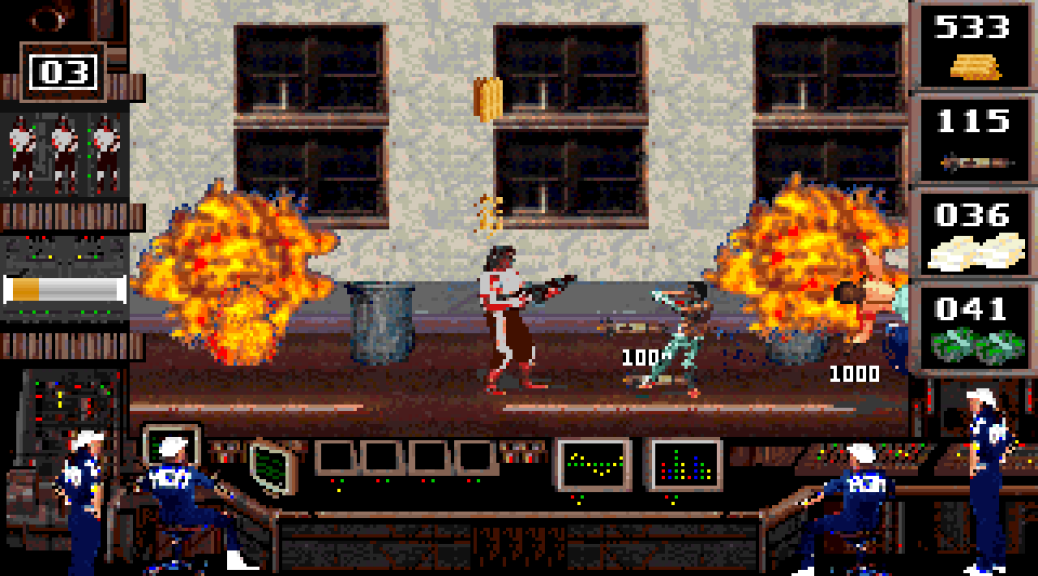Crime Wave is a side-scrolling run-and-gun shooter, developed by The Code Monkeys for Access Software and first published in 1990. It is reminiscent of the 1989 arcade game, Narc, and could in fact be described as a clone of that game.
Tag Archives: 1990
Crime Wave, PC
Developed and published by Access Software in 1990, Crime Wave is a side-scrolling run-and-gun shooter for MS-DOS that uses digitised graphics for the backgrounds, sprites, and cut scenes. Crime Wave – it has to be said – looks and plays like a clone of Williams Electronics‘ 1989 arcade game, Narc, which it almost certainly is.
Kid Dracula, NES/Famicom
Known in Japan as “Akumajō Special: Boku Dracula-kun“, this cute and humorous Castlevania spin-off was initially released by Konami, in Japan only, in 1990, for the Nintendo Famicom. Numerous fan translations exist for the game, but it was also officially released in English for the first time – as “Kid Dracula” – in 2019, in the Castlevania Anniversary Collection. That’s the version I’m showing here.
Sorcerian: Dragon Slayer V, PC
Sorcerian is the fifth instalment in the Dragon Slayer series. It was originally released in 1987 – in Japan – for the PC-88, and the MS-DOS version was converted, localised into English and published by Sierra On-Line in 1990.
Dragon Slayer, Game Boy
A Game Boy port of Falcom‘s maze-based fantasy action game, Dragon Slayer, was developed by Epoch Co., Ltd. and published by Falcom – in Japan only – in 1990. While Dragon Slayer is an ideal match for Nintendo‘s monochrome handheld marvel, this conversion does leave a bit to be desired.
Rainbow Islands Extra Version, Megadrive/Genesis
The “Extra Version” of Taito‘s classic Rainbow Islands is a modified version of the original arcade game, where the levels have been rearranged and the enemies changed to make the game more challenging. There are some new power-ups to discover, and the bosses have also been changed too. Rainbow Islands Extra was released into arcades in limited quantities in 1988, and was also released on the Sega Megadrive in 1990 and the FM Towns in 1992.
Continue reading Rainbow Islands Extra Version, Megadrive/Genesis
Double Dungeons, PC Engine
Developed by NCS Corporation and published by Masaya Games in Japan and NEC in North America in 1990, Double Dungeons is a one or two-player, first-person, dungeon-crawling JRPG with real-time combat. The game’s unique selling point is that it features two-player split-screen cooperative play, which is unusual for a game like this, and which makes it simultaneously playable with a friend.
RoboCop 2, ZX Spectrum
Based on Irvin Kirshner‘s underrated 1990 sequel to RoboCop, in RoboCop 2 you once again take the role of the cyborg cop of the future in order to uphold the law and protect the innocent. RoboCop 2 was developed and published by Ocean Software and released soon after the film came out.
Swords and Serpents, NES/Famicom
Developed by Interplay Productions and published by Acclaim Entertainment in 1990, Swords and Serpents is a first-person, party-based RPG with tile-based movement for up to four players. You can either build a party of four characters yourself, in single-player mode, or up to four different players can control one party member each in multiplayer mode*.
*= An adapter, like the ‘NES Satellite‘, or another four-player expansion peripheral, is required if you’re going to play with that many players (but, let’s face it, very few will, although it’s nice – and fairly unique – to have the option to do that).
Trog, Arcade
Trog is an arcade maze game developed by Midway Manufacturing and distributed on their Bally Midway label in 1990. It caters for up to four simultaneous players and features “Claymation” characters and cut scenes (although they call it “PLAYmation” on the title screen, probably because the word “Claymation” is trademarked). Claymation is when all the characters are made of, and animated with, plasticine or coloured clay (think Wallace & Gromit and you’ll get it).









